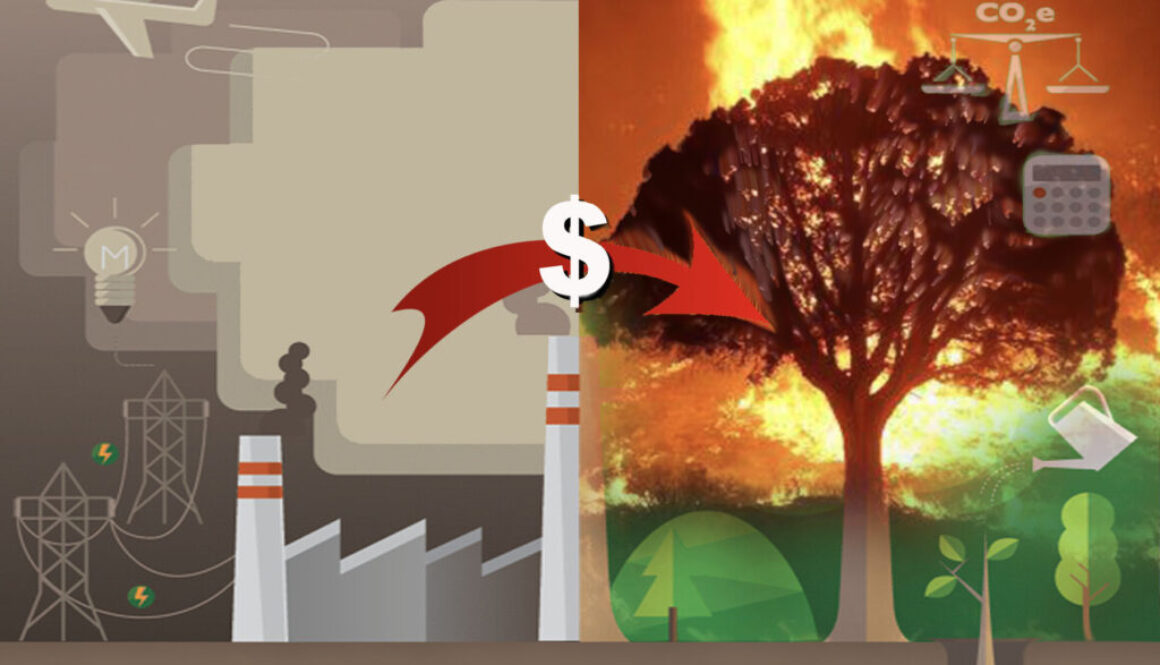
biodiversity

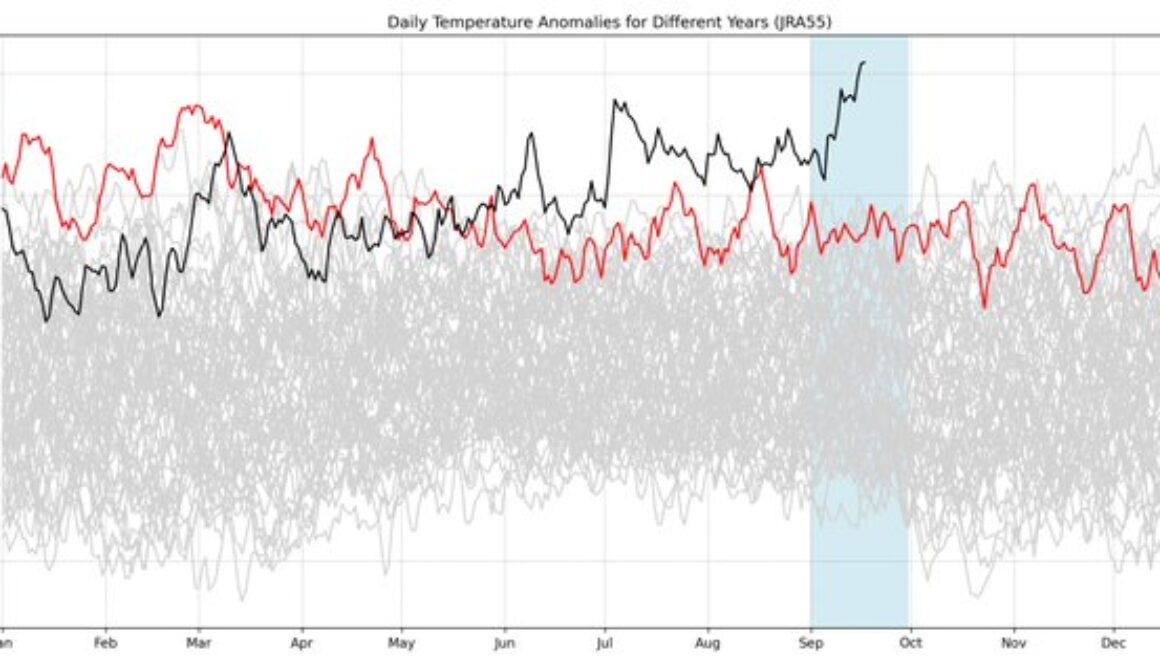
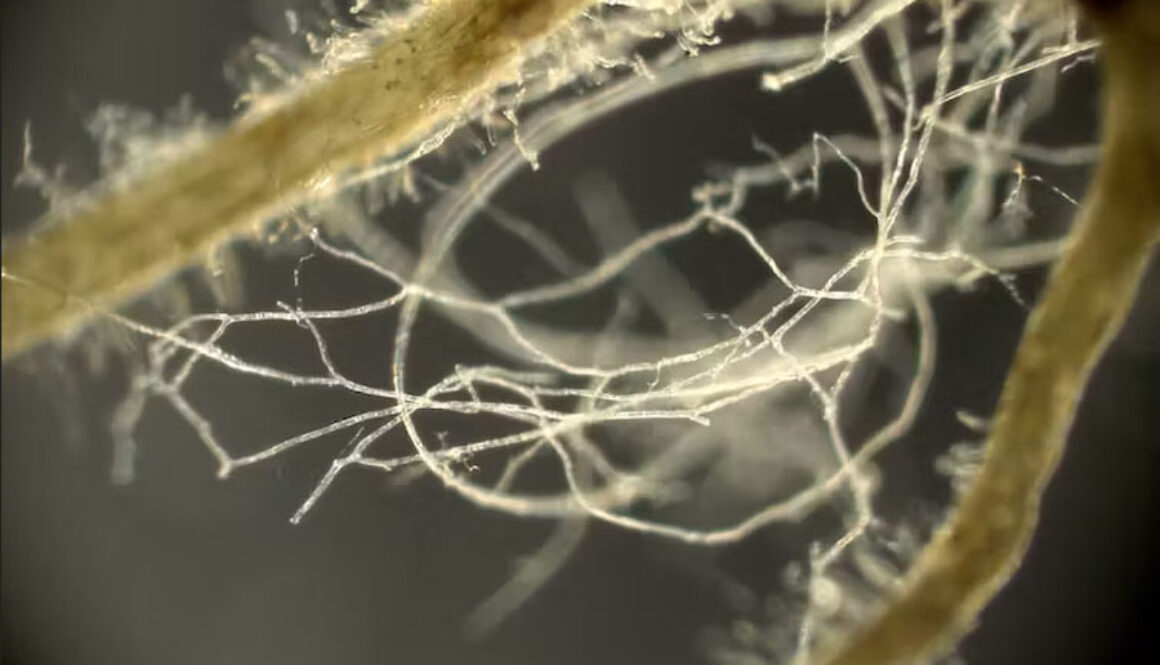
This article is republished from The Conversation under a Creative Commons license. Read the original article.
Authors: Adam Frew, Lecturer and ARC DECRA Fellow, Western Sydney University; Carlos Aguilar-Trigueros, Postdoctoral fellow, Western Sydney University; Jeff Powell, Professor and ARC Future Fellow, Western Sydney University, and Natascha Weinberger, Postdoctoral Research Fellow, Western Sydney University
Beneath our feet, remarkable networks of fungal filaments stretch out in all directions. These mycorrhizal fungi live in partnership with plants, offering nutrients, water and protection from pests in exchange for carbon-rich sugars.
Now, new research shows this single group of fungi may quietly be playing a bigger role in storing carbon than we thought.
How much bigger? These microscopic filaments take up the equivalent of more than a third (36%) of the world’s annual carbon emissions from fossil fuels – every year.
As we search for ways to slow or stop the climate crisis, we often look to familiar solutions: cutting fossil fuel use, switching to renewables and restoring forests. This research shows we need to look down too, into our soils.
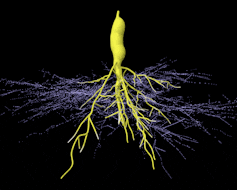
This fungi-plant partnership is 400 million years old
Mycorrhizal fungi are hard to spot, but their effects are startling. They thread networks of microscopic filaments through the soil and into the roots of almost every plant on earth.
But this is no hostile takeover. They’ve been partnering with plants for more than 400 million years. The length of these complex relationships has given them a vital role in our ecosystems.
Sometimes fungi take more than they give. But often, these are relationships of mutual benefit. Through their network, the fungi transport essential nutrients and water to plants, and can even boost their resistance to pests and disease.
In return, plants pump sugars and fat made by photosynthesis in their leaves down through their roots to the fungi. These compounds are rich in carbon, taken from the atmosphere.
How do these fungi fit into the carbon cycle?
On land, the natural carbon cycle involves a delicate balance. Plants take CO₂ from the atmosphere through photosynthesis, while other organisms emit it back into the atmosphere.
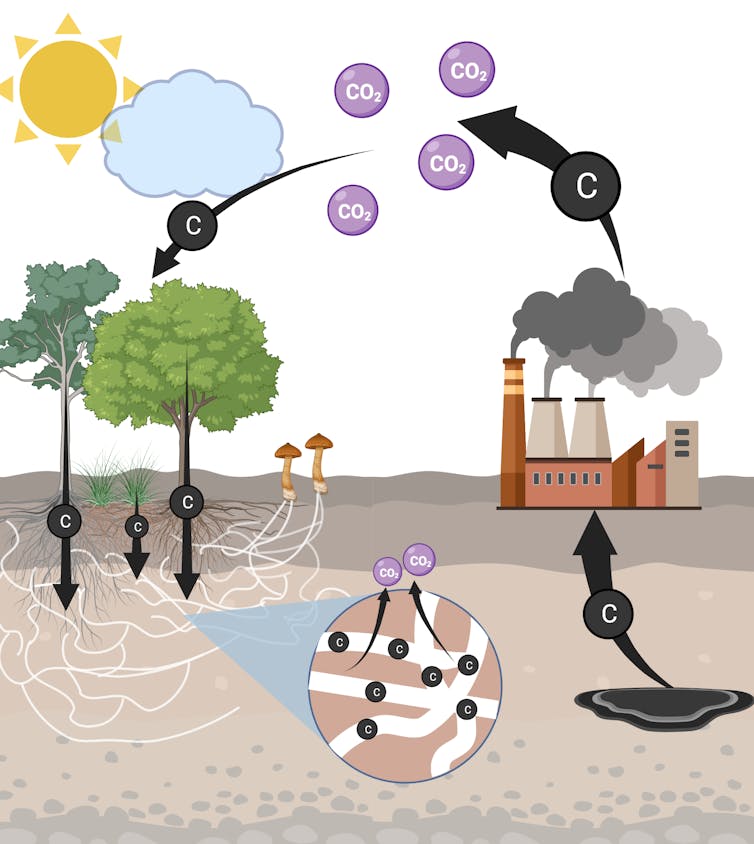
Carbon is captured by plants through photosynthesis, some of this carbon then goes into the networks of mycorrhizal fungi. These fungi also will release some of this carbon as CO₂ and as compounds into the soil. Adam Frew/Author provided using BioRender
Now we know the carbon transfer from plants to mycorrhizal fungi isn’t a side note – it’s a substantial part of this equation.
By analysing almost 200 datasets, the researchers estimate the world’s plants are transferring a staggering 3.58 billion tonnes of carbon per year to this underground network. That’s the same as 13.12 billion tonnes of CO₂ – more than a third of the world’s 36.3 billion tonnes of CO₂ emitted yearly by burning fossil fuels.
To be clear, fungal carbon doesn’t present a climate solution by itself. It’s a missing piece in the carbon cycle puzzle.
We still have big gaps in data from particular ecosystems and geographic regions. For instance, this study didn’t have any data of this kind from Australia or Southeast Asia – because it doesn’t yet exist.
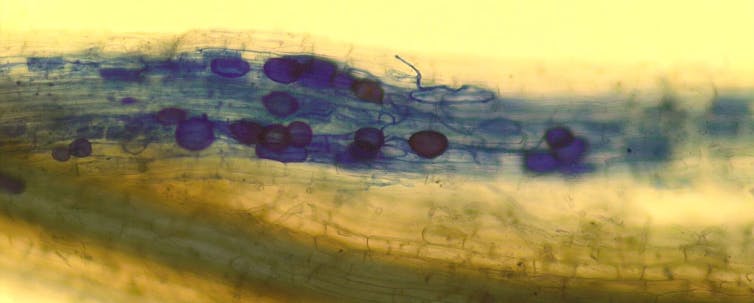
What does this mean for the climate?
We already know mycorrhizal fungi help soils retain carbon by releasing specific chemical compounds. These compounds contain carbon and nitrogen. Once in the soil, these compounds can be used by other soil microorganisms, such as bacteria. When this happens it helps to form a highly stable soil carbon store that is more resistant to breakdown, and this store can accumulate more than four times faster in the presence of mycorrhizal fungi.
When these fungi die, they leave behind “necromass” – a complex scaffold of dead organic material which can be stored in soil, and often inside clumps of soil particles. The carbon inside these clumps can stay in the soil for close to a decade without being released back to the atmosphere.
In fact, other studies suggest this fungal necromass might contribute more to the carbon content of soil than living fungi.
But these fungi also naturally cause carbon to escape back to the atmosphere by decomposing organic matter or changing water and nutrient availability, which influences how other organisms decompose. Mycorrhizal fungi also release some carbon back into the atmosphere, though the rate this happens depends on many factors.
What does this mean for climate change? While atmospheric CO₂ concentrations keep rising, it doesn’t necessarily mean fungi are storing more of it. Recent research in an Australian woodland found higher atmospheric CO₂ did see more carbon sent below the ground. But this carbon wasn’t stored for long periods.
To date, mycorrhizal fungi have been poorly represented in global carbon cycle models. They aren’t often considered when assessing which species are at risk of extinction or promoting successful restorations.
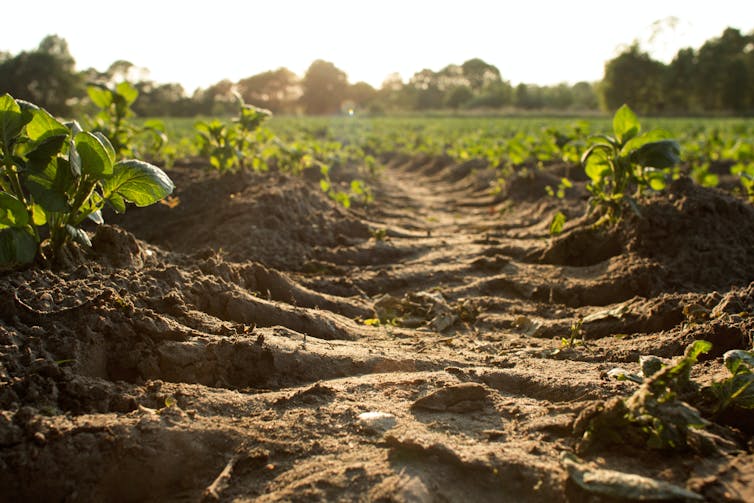
Protecting our fungal networks
When we cut down forests or clear land, we not only disrupt life above the ground, but underground as well. We need to safeguard these hidden fungal networks which give our plants resilience – and play a key role in the carbon cycle.
As we better understand how these fungi work and what we’re doing to them, we can also develop farming methods which better preserve them and their carbon.
As global and Australian initiatives continue to map the diversity of mycorrhizal fungi, scientists are working to understand what shapes these communities and their roles.
We’ve long overlooked these vital lifeforms. But as we learn more about how fungi and plants cooperate and store carbon, it’s well past time for that to change. ![]()
We can’t just sit around and wait to see what will happen next. We need positive action.
I’ve read a lot of Climate Adaptation Plans and Strategies over the past the last few years, but He Toka Tū Moana Mō Maketū (Maketū Climate Change Adaptation Plan) is hand-down the best. It’s clearly laid out, outlines the community’s priorities, and can readily serve as a template to help every community around Aoteara develop their own Climate Adaptation Plans. Most important of all:
It’s iwi led, community driven, it’s a plan that’s been decided by those who live here. – Elva Conroy, Kaitohotohu / Facilitator (Video; to listen Watch on Youtube)
Winner of the 2023 Supreme Planning Awards, the Maketū Climate Change Adaptation Plan was developed by Ngāti Pikiao Environmental Society, Te Rūnanga o Ngāti Whakaue ki Maketū , Whakaue Marae Trustees, and Conroy and Donald Consultants.
In the words of the Maketu Iwi Collective, ‘we will be resilient like the anchor stone Takaparore – strong and steadfast against the elements and tides of change and uncertainty. Regardless of what happens as a result of a changing environment, we will remain standing’. – New Zealand Planning Institute, April 2023.
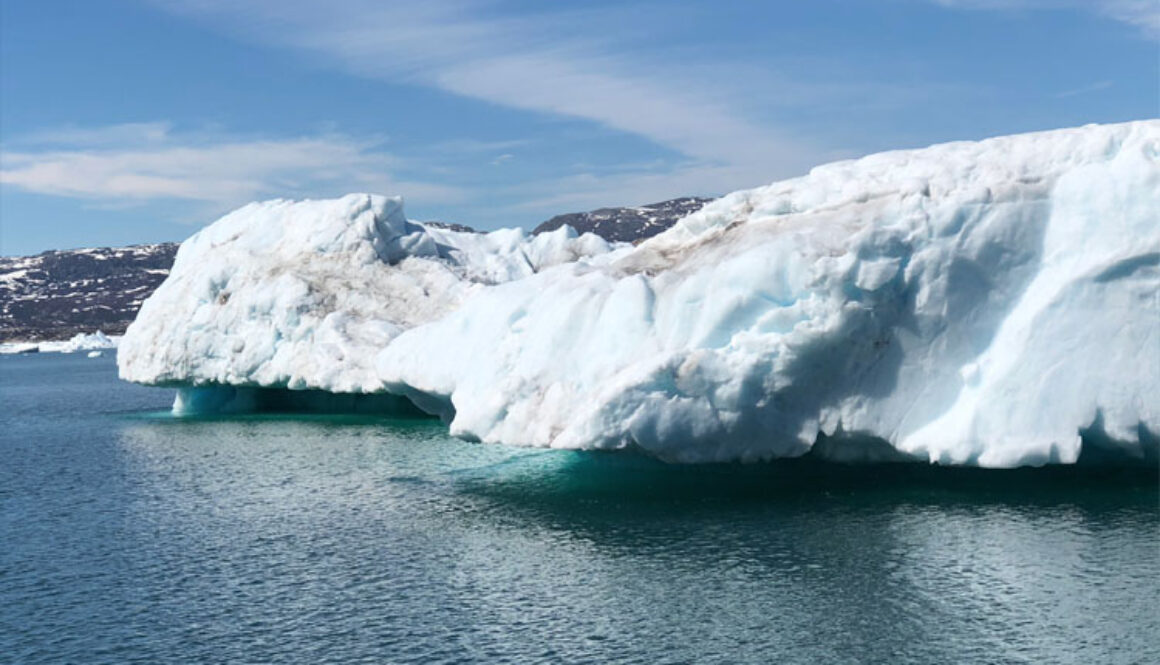
By: Christine Batchelor, Lecturer in Physical Geography, Newcastle University and Frazer Christie, Postdoctoral Research Associate, University of Cambridge
This article is republished from The Conversation under a Creative Commons license. Read the original article.
The Antarctic Ice Sheet, which covers an area greater than the US and Mexico combined, holds enough water to raise global sea level by more than 57 metres if melted completely. This would flood hundreds of cities worldwide. And evidence suggests it is melting fast. Satellite observations have revealed that grounded ice (ice that is in contact with the bed beneath it) in coastal areas of West Antarctica has been lost at a rate of up to 30 metres per day in recent years.
But the satellite record of ice sheet change is relatively short as there are only 50 years’ worth of observations. This limits our understanding of how ice sheets have evolved over longer periods of time, including the maximum speed at which they can retreat and the parts that are most vulnerable to melting.
So, we set out to investigate how ice sheets responded during a previous period of climatic warming – the last “deglaciation”. This climate shift occurred between roughly 20,000 and 11,000 years ago and spanned Earth’s transition from a glacial period, when ice sheets covered large parts of Europe and North America, to the period in which we currently live (called the Holocene interglacial period).
During the last deglaciation, rates of temperature and sea-level rise were broadly comparable to today. So, studying the changes to ice sheets in this period has allowed us to estimate how Earth’s two remaining ice sheets (Greenland and Antarctica) might respond to an even warmer climate in the future.
Our recently published results show that ice sheets are capable of retreating in bursts of up to 600 metres per day. This is much faster than has been observed so far from space.
Pulses of rapid retreat
Our research used high-resolution maps of the Norwegian seafloor to identify small landforms called “corrugation ridges”. These 1–2 metre high ridges were produced when a former ice sheet retreated during the last deglaciation.
Tides lifted the ice sheet up and down. At low tide, the ice sheet rested on the seafloor, which pushed the sediment at the edge of the ice sheet upwards into ridges. Given that there are two low tides each day off Norway, two separate ridges were produced daily. Measuring the space between these ridges enabled us to calculate the pace of the ice sheet’s retreat.
During the last deglaciation, the Scandinavian Ice Sheet that we studied underwent pulses of extremely rapid retreat – at rates between 50 and 600 metres per day. These rates are up to 20 times faster than the highest rate of ice sheet retreat that has so far been measured in Antarctica from satellites.
The highest rates of ice sheet retreat occurred across the flattest areas of the ice sheet’s bed. In flat-bedded areas, only a relatively small amount of melting, of around half a metre per day, is required to instigate a pulse of rapid retreat. Ice sheets in these regions are very lightly attached to their beds and therefore require only minimal amounts of melting to become fully buoyant, which can result in almost instantaneous retreat.
However, rapid “buoyancy-driven” retreat such as this is probably only sustained over short periods of time – from days to months – before a change in the ice sheet bed or ice surface slope farther inland puts the brakes on retreat. This demonstrates how nonlinear, or “pulsed”, the nature of ice sheet retreat was in the past.
This will likely also be the case in the future.
A warning from the past
Our findings reveal how quickly ice sheets are capable of retreating during periods of climate warming. We suggest that pulses of very rapid retreat, from tens to hundreds of metres per day, could take place across flat-bedded parts of the Antarctic Ice Sheet even under current rates of melting.
This has implications for the vast and potentially unstable Thwaites Glacier of West Antarctica. Since scientists began observing ice sheet changes via satellites, Thwaites Glacier has experienced considerable retreat and is now only 4km away from a flat area of its bed. Thwaites Glacier could therefore suffer pulses of rapid retreat in the near future.
Ice losses resulting from retreat across this flat region could accelerate the rate at which ice in the rest of the Thwaites drainage basin collapses into the ocean. The Thwaites drainage basin contains enough ice to raise global sea levels by approximately 65cm.
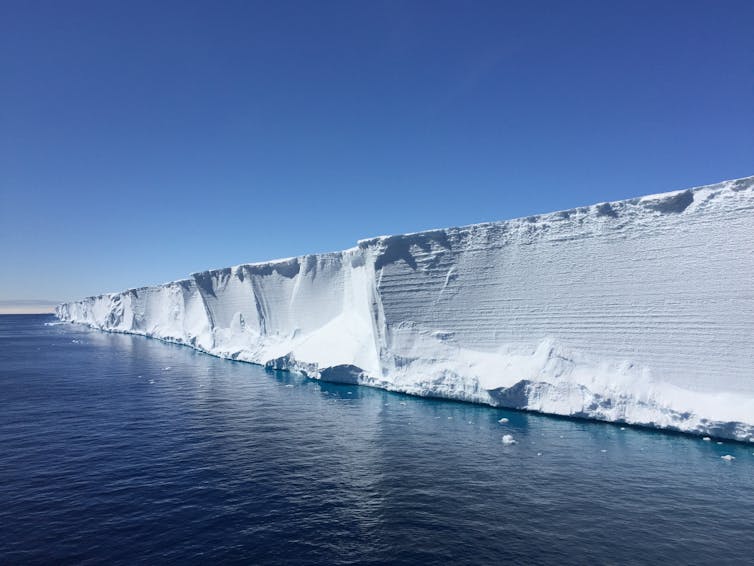
Our results shed new light on how ice sheets interact with their beds over different timescales. High rates of retreat can occur over decades to centuries where the bed of an ice sheet deepens inland. But we found that ice sheets on flat regions are most vulnerable to extremely rapid retreat over much shorter timescales.
Together with data about the shape of ice sheet beds, incorporating this short-term mechanism of retreat into computer simulations will be critical for accurately predicting rates of ice sheet change and sea-level rise in the future.
By: Matthew England, Scientia Professor and Deputy Director of the ARC Australian Centre for Excellence in Antarctic Science (ACEAS), UNSW Sydney; Adele Morrison Research Fellow, Australian National University; Andy Hogg Professor, Australian National University; Qian Li Massachusetts Institute of Technology (MIT); Steve Rintoul CSIRO Fellow, CSIRO.
Republished in full from The Conversation under a Creative Commons license. See the original article: March 3, 2023
Off the coast of Antarctica, trillions of tonnes of cold salty water sink to great depths. As the water sinks, it drives the deepest flows of the “overturning” circulation – a network of strong currents spanning the world’s oceans. The overturning circulation carries heat, carbon, oxygen and nutrients around the globe, and fundamentally influences climate, sea level and the productivity of marine ecosystems.
But there are worrying signs these currents are slowing down. They may even collapse. If this happens, it would deprive the deep ocean of oxygen, limit the return of nutrients back to the sea surface, and potentially cause further melt back of ice as water near the ice shelves warms in response. There would be major global ramifications for ocean ecosystems, climate, and sea-level rise.
Our new research, published today in the journal Nature, uses new ocean model projections to look at changes in the deep ocean out to the year 2050. Our projections show a slowing of the Antarctic overturning circulation and deep ocean warming over the next few decades. Physical measurements confirm these changes are already well underway.
Climate change is to blame. As Antarctica melts, more freshwater flows into the oceans. This disrupts the sinking of cold, salty, oxygen-rich water to the bottom of the ocean. From there this water normally spreads northwards to ventilate the far reaches of the deep Indian, Pacific and Atlantic Oceans. But that could all come to an end soon. In our lifetimes.
Why does this matter?
As part of this overturning, about 250 trillion tonnes of icy cold Antarctic surface water sinks to the ocean abyss each year. The sinking near Antarctica is balanced by upwelling at other latitudes. The resulting overturning circulation carries oxygen to the deep ocean and eventually returns nutrients to the sea surface, where they are available to support marine life.
If the Antarctic overturning slows down, nutrient-rich seawater will build up on the seafloor, five kilometres below the surface. These nutrients will be lost to marine ecosystems at or near the surface, damaging fisheries.
Changes in the overturning circulation could also mean more heat gets to the ice, particularly around West Antarctica, the area with the greatest rate of ice mass loss over the past few decades. This would accelerate global sea-level rise.
An overturning slowdown would also reduce the ocean’s ability to take up carbon dioxide, leaving more greenhouse gas emissions in the atmosphere. And more greenhouse gases means more warming, making matters worse.
Meltwater-induced weakening of the Antarctic overturning circulation could also shift tropical rainfall bands around a thousand kilometres to the north.
Put simply, a slowing or collapse of the overturning circulation would change our climate and marine environment in profound and potentially irreversible ways.
Signs of worrying change
The remote reaches of the oceans that surround Antarctica are some of the toughest regions to plan and undertake field campaigns. Voyages are long, weather can be brutal, and sea ice limits access for much of the year.
This means there are few measurements to track how the Antarctic margin is changing. But where sufficient data exist, we can see clear signs of increased transport of warm waters toward Antarctica, which in turn causes ice melt at key locations.
Indeed, the signs of melting around the edges of Antarctica are very clear, with increasingly large volumes of freshwater flowing into the ocean and making nearby waters less salty and therefore less dense. And that’s all that’s needed to slow the overturning circulation. Denser water sinks, lighter water does not.
How did we find this out?
Apart from sparse measurements, incomplete models have limited our understanding of ocean circulation around Antarctica.
For example, the latest set of global coupled model projections analysed by the Intergovernmental Panel on Climate Change exhibit biases in the region. This limits the ability of these models in projecting the future fate of the Antarctic overturning circulation.
To explore future changes, we took a high resolution global ocean model that realistically represents the formation and sinking of dense water near Antarctica.
We ran three different experiments, one where conditions remained unchanged from the 1990s; a second forced by projected changes in temperature and wind; and a third run also including projected changes in meltwater from Antarctica and Greenland.
In this way we could separate the effects of changes in winds and warming, from changes due to ice melt.
The findings were striking. The model projects the overturning circulation around Antarctica will slow by more than 40% over the next three decades, driven almost entirely by pulses of meltwater.
Over the same period, our modelling also predicts a 20% weakening of the famous North Atlantic overturning circulation which keeps Europe’s climate mild. Both changes would dramatically reduce the renewal and overturning of the ocean interior.
We’ve long known the North Atlantic overturning currents are vulnerable, with observations suggesting a slowdown is already well underway, and projections of a tipping point coming soon. Our results suggest Antarctica looks poised to match its northern hemisphere counterpart – and then some.
What next?
Much of the abyssal ocean has warmed in recent decades, with the most rapid trends detected near Antarctica, in a pattern very similar to our model simulations.
Our projections extend out only to 2050. Beyond 2050, in the absence of strong emissions reductions, the climate will continue to warm and the ice sheets will continue to melt. If so, we anticipate the Southern Ocean overturning will continue to slow to the end of the century and beyond.
The projected slowdown of Antarctic overturning is a direct response to input of freshwater from melting ice. Meltwater flows are directly linked to how much the planet warms, which in turn depends on the greenhouse gases we emit.
Our study shows continuing ice melt will not only raise sea-levels, but also change the massive overturning circulation currents which can drive further ice melt and hence more sea level rise, and damage climate and ecosystems worldwide. It’s yet another reason to address the
climate crisis – and fast.
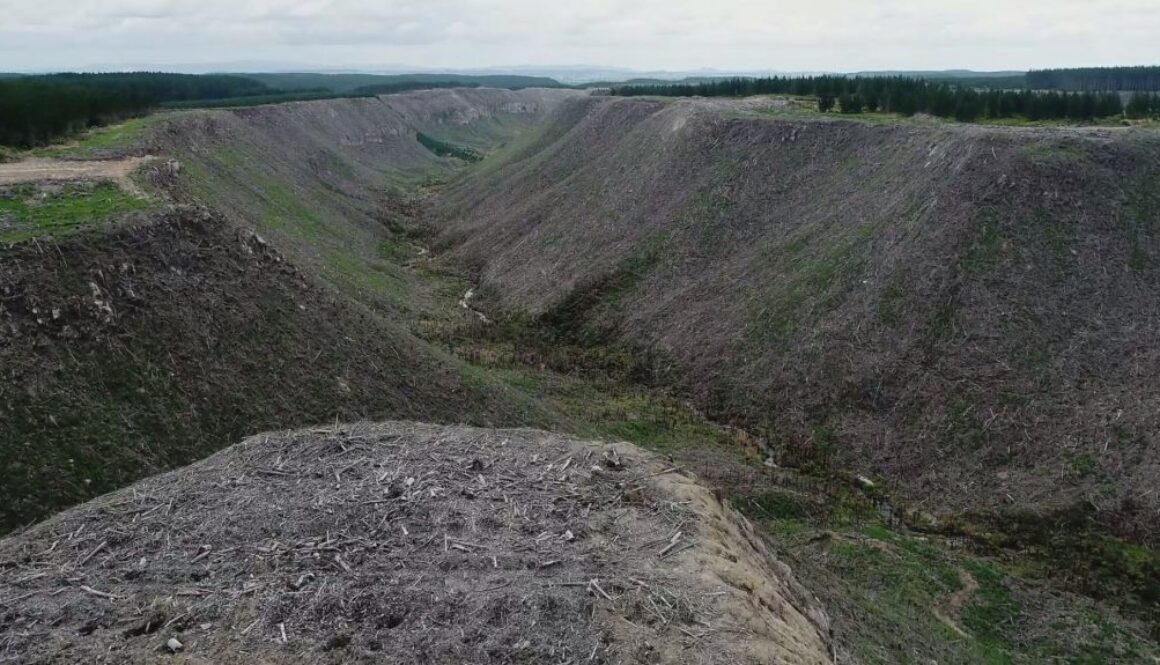
This is such a compelling press release that it’s worth reprinting in full, here:
“The Environmental Defence Society and Pure Advantage have joined forces to draft a submission on the review of the National Environmental Standards for Plantation Forestry (the Standards). The submission seeks significant tightening of the rules governing exotic forest management in Aotearoa New Zealand.
“Our submission starts with the premise that forest practices here are out of step with the rest of the developed world. There are inadequate controls over sediment, slash and soil stability and the sector needs to lift its environmental performance across all of its activities,” said EDS COO Shay Schlaepfer.
“With that in the mind, the scope of the current review, which is focused on permanent exotic carbon forests, is too narrow and we are calling on Government to undertake a fundamental reset of the regulations.“Our submission points to the following key problems with the present Standards:
- It fails to effectively address adverse environmental outcomes associated with plantation forestry activities
- It is unjustifiably and unlawfully permissive for such high risk activities, particularly with regard to afforestation on highly erodible land and clear fell harvesting
- It fails to adequately recognise and encourage the wider and longer-term intergenerational climate resilience, biodiversity, social, cultural, and economic opportunities associated with indigenous forests
- It is insufficiently aligned with national objectives and direction in relation to freshwater, coastal, and indigenous biodiversity protection and long-term carbon sequestration.
“Put in simple terms, the current Standards are failing to address significant adverse environmental effects associated with where trees are planted, whattrees are planted, and how forests are managed and harvested. These effects need to be managed for both new so-called permanent carbon forests and plantation forests.
“We contend that the presumption in the current Standards that forestry activities are “permitted” is unworkable, inappropriate, and ineffective at securing environmental protection.
“We are releasing our draft submission to give some guidance to others wishing to see improvements in the way exotic forests are managed. The intention is to file the final submission on the closing date which is 18 November,” said Ms Schlaepfer.
“The draft submission is available here and feedback can be sent to [email protected]
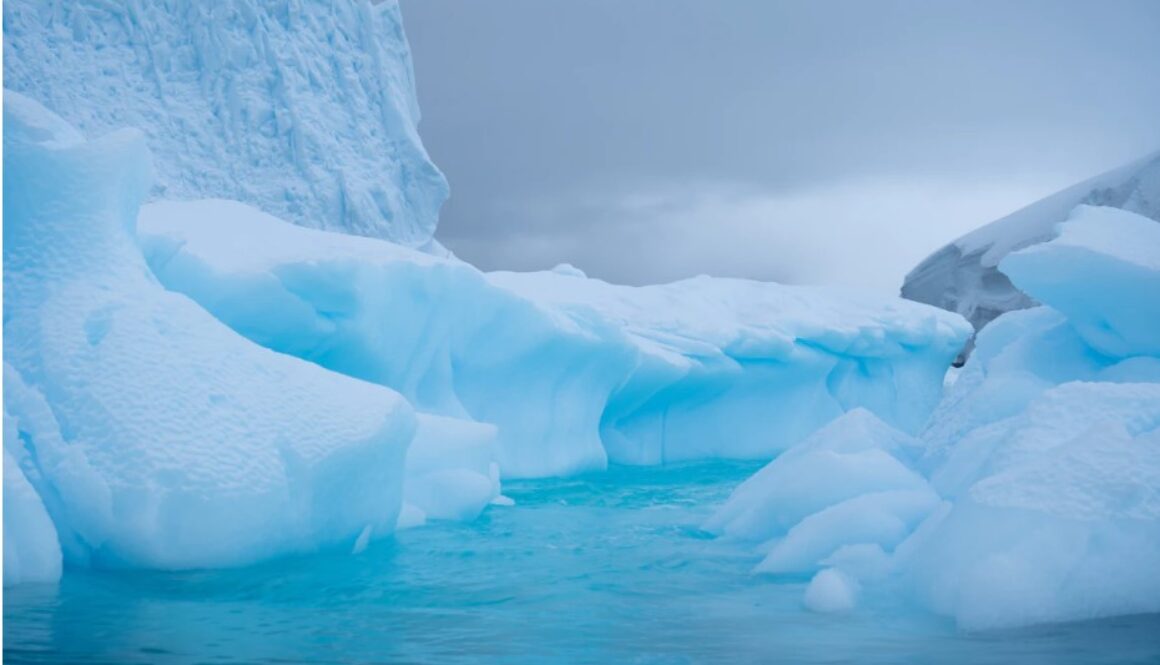
By: Maurice Huguenin, PhD Candidate, UNSW Sydney; Matthew England, Scientia Professor and Deputy Director of the ARC Australian Centre for Excellence in Antarctic Science (ACEAS), UNSW Sydney, and Ryan Holmes, Research fellow, University of Sydney
Republished in full from The Conversation under a Creative Commons license. See the original article: September 7, 2022
Over the last 50 years, the oceans have been working in overdrive to slow global warming, absorbing about 40% of our carbon dioxide emissions, and over 90% of the excess heat trapped in the atmosphere.
But as our research published today in Nature Communications has found, some oceans work harder than others.
We used a computational global ocean circulation model to examine exactly how ocean warming has played out over the last 50 years. And we found the Southern Ocean has dominated the global absorption of heat. In fact, Southern Ocean heat uptake accounts for almost all the planet’s ocean warming, thereby controlling the rate of climate change.
This Southern Ocean warming and its associated impacts are effectively irreversible on human time scales, because it takes millennia for heat trapped deep in the ocean to be released back into the atmosphere.
This means changes happening now will be felt for generations to come – and those changes are only set to get worse, unless we can stop carbon dioxide emissions and achieve net zero.
It’s important yet difficult to measure ocean heating
Ocean warming buffers the worst impacts of climate change, but it’s not without cost. Sea levels are rising because heat causes water to expand and ice to melt. Marine ecosystems are experiencing unprecedented heat stress, and the frequency and intensity of extreme weather events is changing.
Yet, we still don’t know enough about exactly when, where and how ocean warming occurs. This is because of three factors.
First, temperature changes at the ocean surface and in the atmosphere just above track each other closely. This makes it difficult to know exactly where excess heat is entering the ocean.
Second, we don’t have measurements tracking temperatures over all of the ocean. In particular, we have very sparse observations in the deep ocean, in remote locations around Antarctica and under sea ice.
Last, the observations we do have don’t go back very far in time. Reliable data from deeper than 700 metres depth is virtually non-existent prior to the 1990s, apart from observations along specific research cruise tracks.
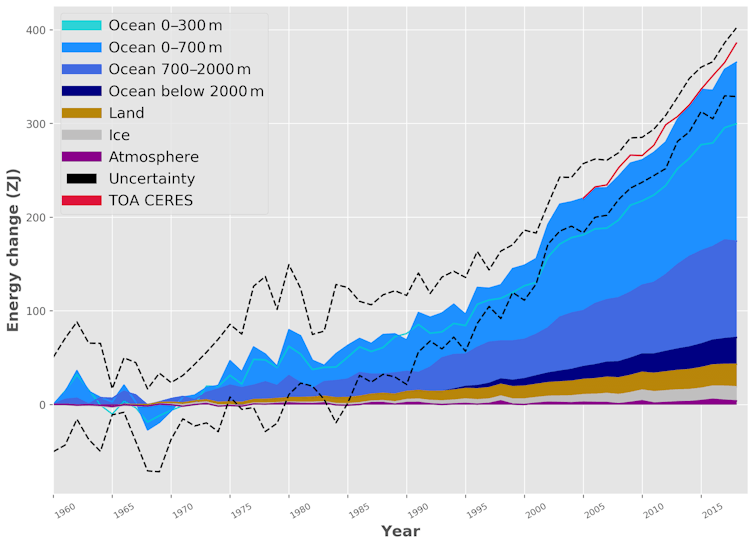
Our modelling approach
To work out the intricacies of how ocean warming has played out, we first ran an ocean model with atmospheric conditions perpetually stuck in the 1960s, prior to any significant human-caused climate change.
Then, we separately allowed each ocean basin to move forward in time and experience climate change, while all other basins were held back to experience the climate of the 1960s.
We also separated out the effects of atmospheric warming from surface wind-driven changes to see how much each factor contributes to the observed ocean warming.
By taking this modelling approach, we could isolate that the Southern Ocean is the most important absorber of this heat, despite only covering about 15% of the total ocean’s surface area.
In fact, the Southern Ocean alone could account for virtually all global ocean heat uptake, with the Pacific and Atlantic basins losing any heat gained back into the atmosphere.
One significant ecological impact of strong Southern Ocean warming is on Antarctic krill. When ocean warming occurs beyond temperatures they can tolerate, the krill’s habitat contracts and they move even further south to cooler waters.
As krill is a key component of the food web, this will also change the distribution and population of larger predators, such as commercially viable tooth and ice fish. It will also further increase stress for penguins and whales already under threat today.
So why is the Southern Ocean absorbing so much heat?
This largely comes down to the geographic set-up of the region, with strong westerly winds surrounding Antarctica exerting their influence over an ocean that’s uninterrupted by land masses.
This means the Southern Ocean winds blow over a vast distance, continuously bringing masses of cold water to the surface. The cold water is pushed northward, readily absorbing vast quantities of heat from the warmer atmosphere, before the excess heat is pumped into the ocean’s interior around 45-55°S (a latitude band just south of Tasmania, New Zealand, and the southern regions of South America).
This warming uptake is facilitated by both the warmer atmosphere caused by our greenhouse gas emissions, as well as wind-driven circulation which is important for getting heat into the ocean interior.
And when we combine the warming and wind effects only over the Southern Ocean, with the remaining oceans held back to the climate of the 1960s, we can explain almost all of the global ocean heat uptake.
But that’s not to say the other ocean basins aren’t warming. They are, it’s just that the heat they gain locally from the atmosphere cannot account for this warming. Instead, the massive heat uptake in the Southern Ocean is what has driven changes in total ocean heat content worldwide over the past half century.
We have much to learn
While this discovery sheds new light on the Southern Ocean as a key driver of global ocean warming, we still have a lot to learn, particularly about ocean warming beyond the 50 years we highlight in our study. All future projections, including even the most optimistic scenarios, predict an even warmer ocean in future.
And if the Southern Ocean continues to account for the vast majority of ocean heat uptake until 2100, we might see its heat content increase by as much as seven times more than what we have already seen up to today.
This will have enormous impacts around the globe: including further disturbances to the Southern Ocean food web, rapid melting of Antarctic ice shelves, and changes in the ocean conveyor belt.
To capture all of these changes, it’s vital we continue and expand our observations taken in the Southern Ocean.
One of the most important new data streams will be new ocean floats that can measure deeper ocean temperatures, as well as small temperature sensors on elephant seals, which give us essential data of oceanic conditions in winter under Antarctic sea ice.
Even more important is the recognition that the less carbon dioxide we emit, the less ocean change we will lock in. This will ultimately limit the disruption of livelihoods for the billions of people living near the coast worldwide.
